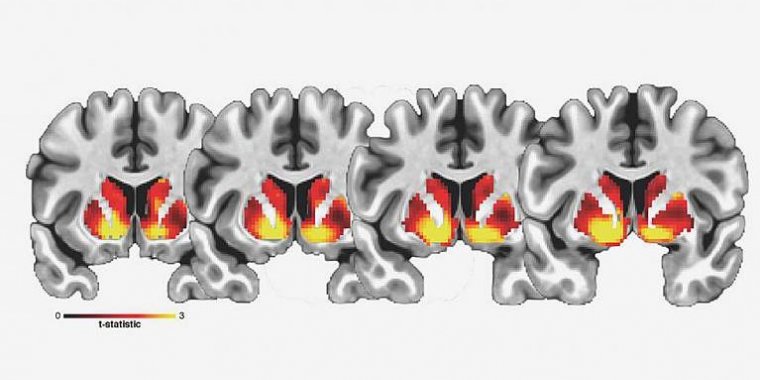| News / Science News |
Study links adolescent brain differences to increased waist circumference
Differences in the microstructure of the nucleus accumbens (NAcc), a region in the brain that plays an important role in processing food and other reward stimuli, predict increases in indicators of obesity in children, according to a study.

Association between cell density at baseline and change in waist circumference one year later. Cellularity in the ventral striatum demonstrates the strongest relationship among all regions in the subcortex. Image modified from Rapuano, Laurent et al PNAS 2020
The paper is based on data from the Adolescent Brain Cognitive Development (ABCD) Study. The ABCD Study will follow nearly 12,000 children through early adulthood to assess factors that influence individual brain development and other health outcomes.
Findings from this study provide the first evidence of microstructural brain differences that are linked to waist circumference and body mass index (BMI) in children. These microstructural differences in cell density could be indicative of inflammatory processes triggered by a diet rich in high fat foods.
“We know that childhood obesity is a key predictor of adult obesity and other poor health outcomes later in life,” said Nora D. Volkow, M.D., director of National Institute on Drug Abuse (NIDA). “These results extend previous animal studies to reveal what may prove to be a vicious cycle in which diet-related inflammation in brain striatal regions promotes further unhealthy eating behaviors and weight gain.”
Evidence from past human imaging studies has demonstrated the relationship between the NAcc and unhealthy eating behavior in adults.
In this study, the researchers leveraged new diffusion MRI imaging techniques to examine the cellular structure of areas that comprise the striatal reward pathway in the brain to investigate disproportionate weight gain in youth.
This study included data from 5,366 ABCD Study participants, ages 9- to 10-years-old at baseline, of whom 2,133 returned for a one-year follow-up visit.
The mean waist circumference of the participants, used here as a measure of body fat, increased an average of 2.76 centimeters per participant from the baseline through the one-year follow-up.
The researchers used a noninvasive MRI technique to show that an alleged marker of cellular density in the NAcc reflected differences in waist circumference at baseline and predicted increased waist circumference at one-year follow-up.
Because the ABCD Study is longitudinal, it will allow to assess if this association holds or changes over the course of adolescent development, and what factors may influence this trajectory. (National Institutes of Health)
YOU MAY ALSO LIKE





